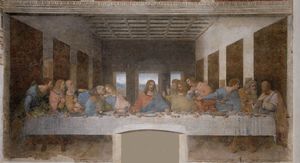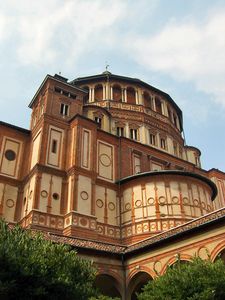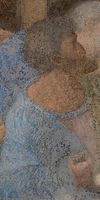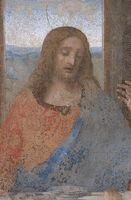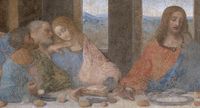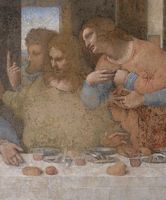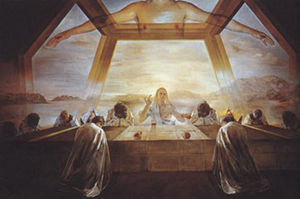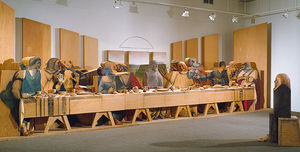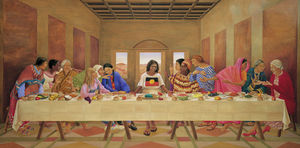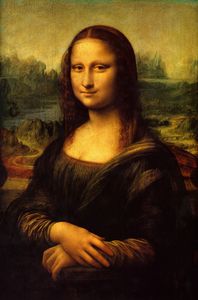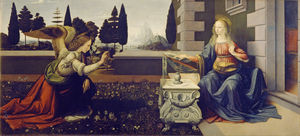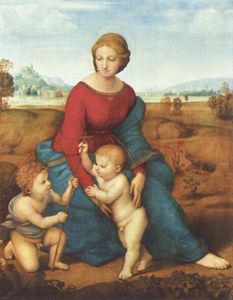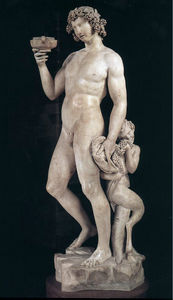The Last Supper
- Date of Creation:
- 1498
- Height (cm):
- 460.00
- Length (cm):
- 880.00
- Medium:
- Tempera
- Support:
- Other
- Subject:
- Figure
- Framed:
- No
- Art Movement:
- Renaissance
- Created by:
- Current Location:
- Milan, Italy
- Displayed at:
- Santa Maria delle Grazie
- Owner:
- Santa Maria delle Grazie
- The Last Supper Page's Content
- Story / Theme
- Analysis
- Related Paintings
- Artist
- Art Period
- Bibliography
The Last Supper Story / Theme
The Last Supp&egravzzz;r was commissioned by Duke Lodovico Sforza, Leonardo's patron, for the dining hall (refectory) of the convent of Santa Maria delle Grazie, in Milan. It took the artist three years to complete and much of that time was spent roaming the streets of Milan looking for models for the figures of Christ and Judas.
The fresco technique of painting directly onto walls was common but Leonardo was not adequately trained and he chose poor materials to carry out this work, and this, combined with the convent's humid conditions, meant that The Last Supper began to deteriorate during Leonardo's lifetime.
The artwork was also caught up in the bombing of the refectory during the Second World War, but it had a lucky escape, with some carefully positioned sandbags saving it from destruction.
The theme of The Last Supper was a traditional one for refectories and portrayed Jesus gathering his disciples to wash their feet (symbolizing their equality in the eyes of the Lord) and announcing that one of them would soon betray him. Like other versions from this period, Leonardo places the disciples on one side of the table, facing the viewer.
However, unlike earlier works which showed Judas as separate from the other attendees, or without a halo, Leonardo depicted Judas resting in the shadows.
The Last Supper makes several references to the number three, representing the Christian belief in the Holy Trinity. The disciples are clustered in groups of three; there are three windows behind Jesus, and his face is a triangular shape. The deterioration of this piece means that other references may have been lost over time.
The Last Supper Analysis
Leonardo's version of The Last Supper draws inspiration from each of the four Gospels and represents the moment immediately after Christ has informed his disciples that one of them will betray him before sunrise. The artist is successful in conveying their feelings of horror, anger and shock and he displays very human emotions. Although a common subject in art at the time, Leonardo's painting was the first to illustrate real people acting as such.
Perspective:
Another notable aspect of The Last Supper is its technical perspective. Every element of the image draws the viewer's attention to the foreground and Christ's head. The window directly behind him acts as a halo and Judas is the only figure who leans away from Christ and is painted in shadow. Some critics argue that this is the greatest example of one point perspective ever created.
Leonardo was clever in his use of perspective because he allowed the observer to see the table top, even though it shouldn't be possible. Furthermore, there are a number of people crowded round the table and not enough seats.
Use of light:
The angles and lighting draw attention to the center of the composition and the figure of Jesus, whose head is positioned at the vanishing point, where all of the perspective lines meet.
Materials used:
Not wanting to limit the amount of time he could spend on this painting, Leonardo created it using new pigments on the dry wall rather than mixing them with wet plaster. This means that the work cannot be classified as a true fresco and sadly, due to this poor choice of materials, it began to deteriorate just a few years after its completion.
Attempts to restore The Last Supper have often worsened rather than enhanced the artwork. However, a full restoration has been carried out and took twenty years to finish - five times longer than Leonardo took to complete the work. Today it is thought that little of the original fresco actually remains.
The Last Supper Related Paintings
The Last Supper Artist
Leonardo da Vinci's The Last Supper is a painting that helped establish his fame as a painter and it remains one of his most valued works and one of the most replicated artworks in the world.
Created during the middle years of his career, this fresco perfectly illustrates his belief that poses, gestures and facial expressions should mirror the actions of the soul and mind. Despite Leonardo's concerns over painting the faces of his figures, The Last Supper was immediately hailed a stunning success of design and detail.
Works such as The Last Supper, Mona Lisa and Vitruvian Man are among the most esteemed in the history of art, rivaled only by the masterpieces of Michelangelo. If it was not for Leonardo's inability to complete his paintings he may have added more works to his oeuvre but this, together with his experimentation with new techniques, means that only around fifteen of his works exist today.
Leonardo's mission was to find a universal language for painting and with perspective and other realistic elements he aimed to design accurate renditions of life. This was extremely bold in a culture previously dominated by highly symbolic and strange religious artworks, and this focus on objectivity became the standard for emerging painters in the 16th century.
The Last Supper Art Period
In art history, the High Renaissance was a time denoting the pinnacle of the visual arts in the Italian Renaissance. Most agree that the High Renaissance began in the 1490s, with Leonardo's fresco of The Last Supper in Milan and ended in 1527 with the sacking of Rome by the troops of Charles V.
The High Renaissance was a time of outstanding artistic production in Italy and the best-known examples of Italian Renaissance painting derive from artists such as Leonardo da Vinci, Michelangelo and a young Raphael.
The images in the Vatican by Michelangelo and Raphael are the epitome of High Renaissance art and their size, ambitious compositions, detailed figures and iconographic references to classical antiquity, are emblematic of this period.
Although typically named as the three giants of the High Renaissance, Leonardo, Michelangelo and Raphael were not of the same age. Leonardo was the eldest; he was twenty-three when Michelangelo was born and thirty-one when Raphael was born. Raphael died in 1520 at the age of 37, the year after Leonardo, but Michelangelo's career spanned a further 45 years.
The Last Supper Bibliography
To explore further about the life and works of Leonardo da Vinci please select from the following recommended sources.
• Brown, David Alan. Leonardo da Vinci: Origins of a Genius. Yale University Press, 1998
• Da Vinci, Leonardo. Drawings. Dover Publications Inc. , 1980
• Jones, Jonathan. The Lost Battles: Leonardo, Michelangelo and the Artistic Duel That Defined the Renaissance. Simon & Schuster Ltd. , 2010
• Kemp, Martin. Leonardo da Vinci: The Marvellous Works of Nature and Man. OUP Oxford, 2007
• Marani, Pietro C. Leonardo Da Vinci: The Complete Paintings. Harry N. Abrams, Inc. , 2003
• Syson, Luke. Leonardo Da Vinci: Painter at the Court of Milan. National Gallery Company Ltd. , 2011
• Vezzosi, Alessandro. Leonardo da Vinci: Renaissance Man. Thames & Hudson, 1997
• Zollner, Frank & Nathan, Johannes. Leonardo Da Vinci: The Complete Paintings and Drawings. Taschen GmbH, 2007

